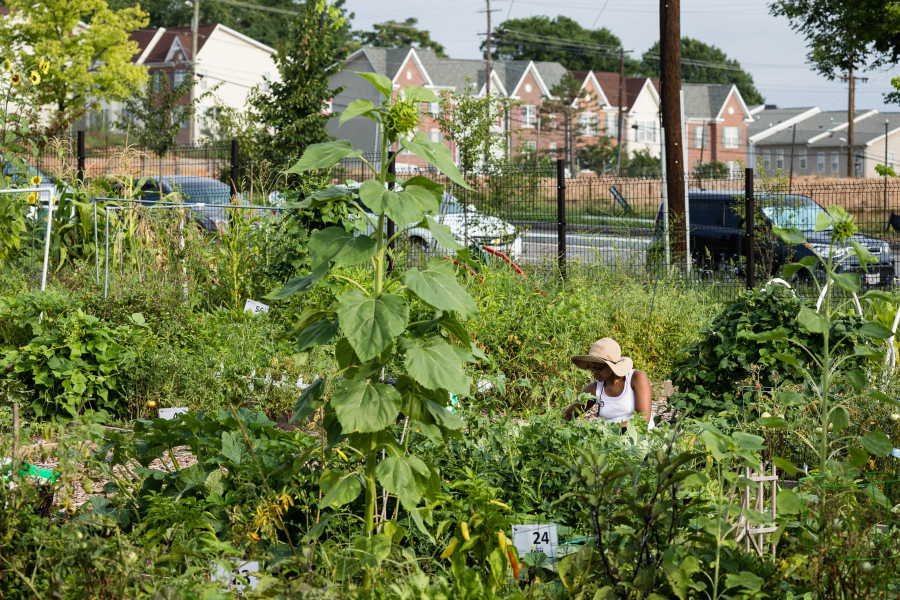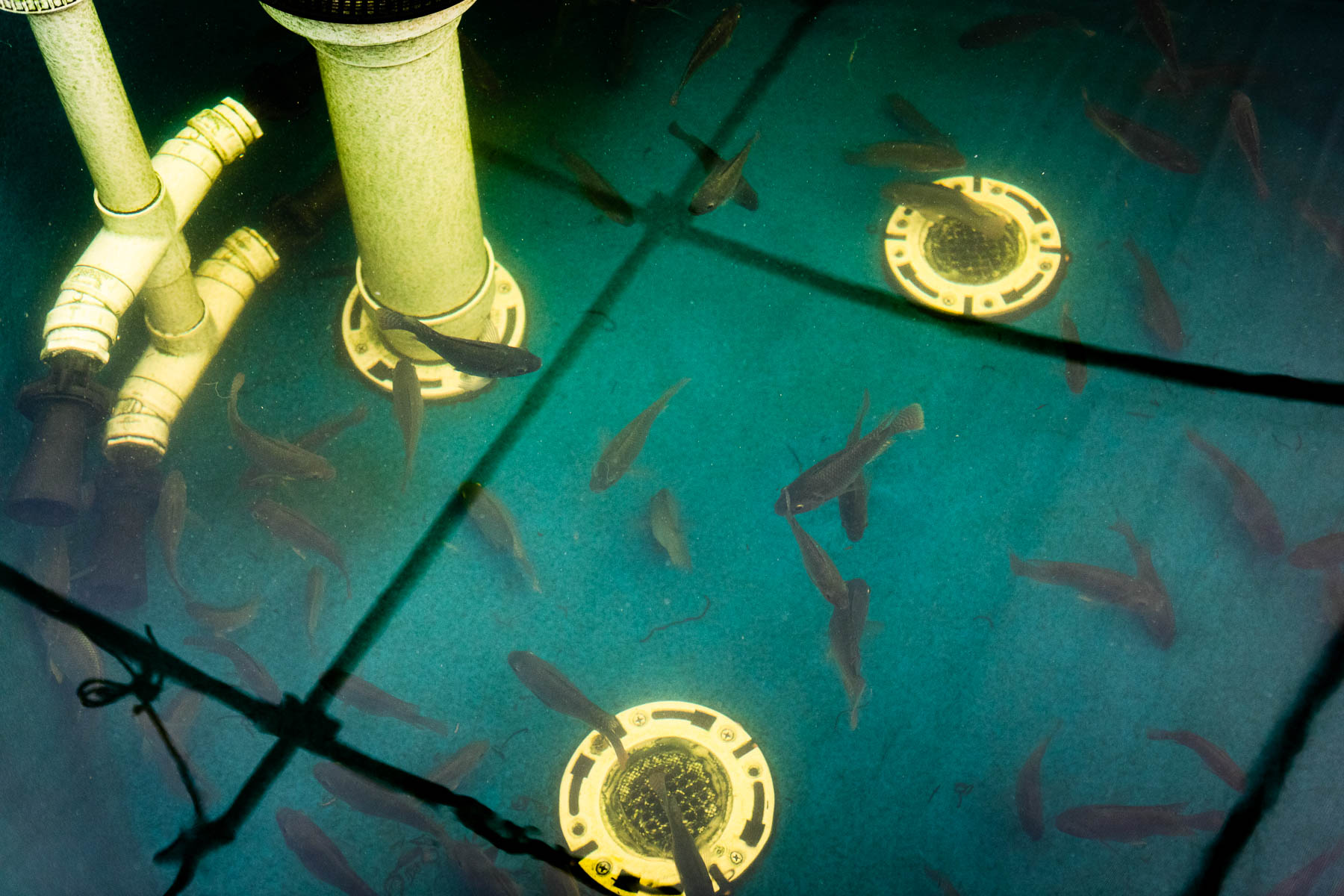Gardening in the heart of the city
Nexus for learning, food and healing grows in DC food hubs

On an early, clear morning in southeast Washington, D.C., behind a chain link fence on the corner of a busy intersection, a muscled, former military man named Mustafa prepares to throw punches. He’s also here to care for some seedlings.
Mustafa Bey comes a few mornings a week to East Capital Urban Farm, where he teaches urban defense classes and maintains a garden plot. Garden plots that show the individual tastes of their caretakers dot the landscape, with community art interspersed in colorful patches. Bey, a former police officer and former marine, looks over his morning harvest. “[I began to garden] to get away from all the killings and the violence. Now I grow squashes.”
East Capitol Urban Farm provides this place of healing, health and renewal for all residents of the area that want to participate. Once a vacant parcel of land, the farm is now a three-acre green space for the economically disadvantaged and predominantly African-American Ward 7 community, created as a partnership with the University of the District of Columbia College of Agriculture, Urban Sustainability and Environmental Sciences (UDC CAUSES). Garden plots are managed by individual members of the community, and each church and school in the neighborhood has their own collective plot for the students. Community classes have sprung up in this safe space, some offered through UDC and some, like Bey’s urban defense classes, created organically from the community.
Andrea Christie, a spry, bright-eyed woman of 60, is warming up for Bey’s class by the community mural. She and her daughter, Mia Smith, are in their first year of planting at the garden and have chosen to grow peppers of all varieties, hot and sweet. Christie and Bey became acquainted through the local high school, where Bey was teaching gym classes, and both took up plots at the garden. Combating domestic violence, Bey explains, has always been a cause close to his heart. He realized that the community garden would be the perfect venue to teach women defense. The class currently consists of Christie, Smith and Charlene Bradshaw, a friend of Christie’s who is just beginning to join the morning workouts.
Bradshaw and Christie walk through the garden, taking in the growth stages of the many plant varieties. “Mmmmm!” Bradshaw, an Army veteran, stops up short at a plot filled almost completely with okra. “That looks like a good West African meal there.” She explains the dish fufu, a mashed starch dish, and pauses again, deliberating. “I may have to make me some fufu when I get home.”

East Capitol Urban Farm contains the ordinary produce one might expect to see at the grocery store as well as several exotic plants more familiar to the local residents. West African plants are being grown in separate plots by UDC, with large informational signs stuck into each bed to educate visitors to the garden. Garden egg, indigenous to Ghana, is a leafy plant that also produces curious white fruit. The leaves of this plant are an excellent source of nutrition and a staple in West Africa. Sawa Sawa, a plant both highly nutritious and fun to say, is used as a leaf green in Sierra Leone and the flowers for tea.
A shed on the property also houses the beginnings of an aquaponics system, with classes available on its care. Aquaponics is a closed system of conservation: fish in tanks deposit nutrients into the water, which feeds the plants; in turn, the plants oxygenate the water, which then refreshes the tanks of the fish.
A partnership between UDC CAUSES, the DC Housing Authority, the Urban Waters Federal Partnership, the DC Building Industry Association, District Department of Energy and Environment, Groundwork Anacostia and the DC Commission on the Arts and Humanities, has created a multitude of community efforts on the farm. A farmers market is provided on-site with community members as both vendors and customers. Dawn Mabery Chestnut, a community resident adorned with a wide brimmed sun hat and perched in her garden plot, explains a recent health initiative offered at East Capitol: “The Kaiser Permanente truck came. If you got a free health screening, you also got a ten dollar coupon for the farmer’s market.”
Initiatives that marry health, wellness, nutrition, active participation and community are the goal for East Capitol and other endeavors like it. Chestnut, who got her body mass index, weight, blood pressure and other vitals checked on the health day, likes the healthy living opportunities associated with the urban farm. She walks from her house to her garden plot, calling attention to the exercise this builds into her day. Smiling up from the garden bed and gesturing with her spade, she says, “I always said when I have a house, I’m going to have a garden.” Now living in her own home, East Capitol Urban Farm gives her a chance to fulfill that dream.

Just a few miles away in Beltsville, Maryland is Firebird Research Farm, the research side of the urban farming endeavor for the University of the District of Columbia, where the university is working to adapt successful farming techniques to urban landscapes like East Capitol. Where the aquaponics system at East Capitol is in its infancy, the one at Firebird is robust: goldfish and tilapia churn the water in tanks beside a three-step filtration system, with the fruits of their efforts shown in the bursts of bright green basil popping from the white aquaponics unit in the same room. An aquaponics system in full working order uses up to 90 percent less water than traditional agricultural watering practices. Here too, they are working to weave in community endeavors and provide successful pathways for future careers. The university’s Nutrition and Dietetics Center is working to set up a program to package and market the fish as they reach the end of their life span.
Excess food at Firebird is donated back to the community, and guidance is provided to teach recipients how to use unfamiliar crops. Yao Agantchao, the ethnic crops specialist at Firebird, even developed a recipe book to capture the culture of Africa within the dishes. Other crops are being harvested by groups in the community—including the Internal Revenue Service (IRS). Members of the IRS come on a Saturday to help harvest basil, rainbow chard and collard greens through the “Feds Feed Families” program. Renee Bellis, staff assistant for UDC and coordinator of much that goes on at the facilities, works with Food Rescue DC to transport the harvests to a pantry in need.
Academic research, community vibrancy, aid and assistance, federal efforts, cutting edge agricultural advances and cultural education are often treated as separate endeavors that do not naturally overlap, vying for resources and funds. The success of East Capitol Urban Farm, the progress of Firebird Research Farm and the coming together of a community show that all of these specialties thrive when conducted in partnership with each other.
To request a community garden plot at the East Capital Urban Farm, please visit this page.
To view more photos, visit the Chesapeake Bay Program's Flickr page.

Comments
There are no comments.
Thank you!
Your comment has been received. Before it can be published, the comment will be reviewed by our team to ensure it adheres with our rules of engagement.
Back to recent stories